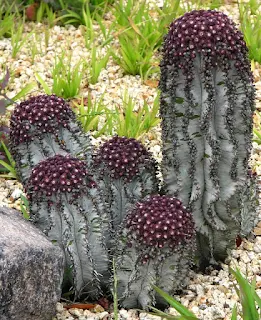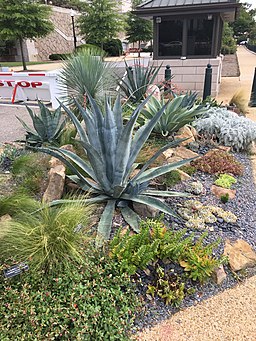What is Xeriscaping?
Xeriscaping is a landscaping technique that focuses on creating a water-efficient and sustainable garden or landscape. It may sound like a cheesy science book from the 70s but, the term "xeriscape" is derived from the Greek word "xeros," meaning dry, and "scape," meaning scene or view. Xeriscaping is particularly popular in areas that experience drought or where water resources are limited.
Goal of Xeriscaping
The primary goal of xeriscaping is to reduce the amount of water required to maintain a garden or landscape, while still creating an attractive and functional outdoor space. This is achieved by using a variety of water-efficient plants, mulch, and other materials that require minimal watering, and by incorporating features such as rain barrels and drip irrigation systems to maximize the use of available water.
In addition to conserving water, xeriscaping can also provide many environmental benefits. By reducing the amount of water needed to maintain a garden or landscape, xeriscaping can help to conserve natural resources and reduce water usage. Xeriscaping can also promote biodiversity by providing habitats for a variety of plant and animal species, including bees and other pollinators.
Moreover, xeriscaping can be an effective way to reduce the use of pesticides and fertilizers, which can be harmful to both the environment and human health. By using a combination of natural materials, such as compost and mulch, and native plants that are adapted to the local environment, xeriscaping can help to create a healthy and sustainable outdoor space.
Reasons to Consider Xeriscaping
Water Conservation: The Heart of Xeriscaping
Xeriscaping is synonymous with water efficiency. Designed to require minimal water, this method employs drought-tolerant plants and state-of-the-art irrigation systems, such as drip irrigation and rain barrels. The result? Dramatic water conservation that's particularly crucial in arid regions or during drought conditions. When you xeriscape, you're not just saving money on your water bill—you're participating in responsible water management, which is increasingly critical in our changing climate.
Reduce Chemical Use, Enhance Well-Being
One of the less-discussed but equally important advantages of xeriscaping is its reduced dependence on harmful chemicals. Traditional lawns often require fertilizers, pesticides, and herbicides, substances that can negatively impact both environmental and human health. With xeriscaping, the use of native and drought-tolerant plants minimizes the need for these chemicals, making your outdoor space safer for you and the environment.
Foster Biodiversity: The Unsung Hero of Eco-Friendly Landscaping
When you choose to xeriscape, you're essentially rolling out the welcome mat for a host of local wildlife. Native plants naturally attract local fauna, including beneficial insects, birds, and even small mammals. Not only does this create a thriving mini-ecosystem in your backyard, but it also aids in natural pest control and pollination. The upshot? A healthier environment that promotes biodiversity.
Cut Down on Maintenance, Up Your Free Time
If you dread the weekend routine of mowing, watering, and fertilizing, xeriscaping is for you. Native plants, once established, typically require little maintenance, freeing you from the shackles of yard work. You get to enjoy an attractive outdoor space without the constant upkeep—a win-win scenario that also conserves valuable resources.
Beautify Your Space, the Sustainable Way
The beauty of xeriscaping is not just skin deep. With a tapestry of drought-resistant plants offering different colors, shapes, and textures, your yard becomes a visual feast. Contrary to popular belief, xeriscaping can yield stunning results, rivaling the aesthetics of conventional gardens.
So, are you ready to make the switch? With benefits ranging from water conservation to beautification, xeriscaping offers a sustainable and visually pleasing alternative to traditional lawns. It's the ideal solution for anyone looking to reduce their environmental impact while still enjoying a beautiful, low-maintenance yard.
Xeriscaping Plants: Drought-Tolerant Flora for Your Sustainable Garden
Looking to create a sustainable, water-efficient garden? You're in the right place! Our comprehensive list of xeriscaping plants offers options that are both drought-tolerant and beautiful.
Succulents: The Go-To for Dry Conditions
- Aloe Vera: A popular household plant known for its medicinal uses.
- Jade Plant: Perfect for beginners and requires minimal care.
- Agave: Thrives in hot, dry conditions and comes in multiple varieties.
Cacti: The Spiny Champions of Xeriscaping
- Prickly Pear: Offers a unique look and edible fruit.
- Barrel Cactus: Known for its distinctive barrel shape.
- Saguaro: A classic symbol of the American Southwest.
Herbal Delights: Fragrant and Functional
- Lavender: Attracts pollinators and offers a soothing scent.
- Sage: Another pollinator-friendly choice that's also culinary-friendly.

Hard-to-Kill Perennials
- Yucca: Resilient and dramatic in appearance.
- California Poppy: Adds a vibrant touch to any garden with its orange flowers.
Grasses and More: Textural Elements
- Fountain Grass: Offers a feathery, wind-catching appearance.
- Blue Fescue: Known for its blueish hue and clumping growth habit.
Multi-Functional Plants: Culinary and Aesthetic
- Rosemary: A drought-tolerant herb perfect for cooking and landscaping.
- Penstemon: Offers a burst of color and attracts pollinators.
The Pollinator Magnets
- Echinacea: Diverse in color and great for attracting bees.
- Verbena: Comes in shades like purple and pink; attracts butterflies.
Evergreen Choices for Year-Round Greenery
- Juniper: Available in many forms, from low-lying to upright shrubs.
The Unsung Heroes: Lesser-Known Drought-Tolerant Plants
- Catmint: Delivers shades of blue and purple and is easy to care for.
- Honeysuckle: Vine-forming and offers fragrant blooms.
Colorful Annuals and Perennials
- Gaillardia: Features stunning red and yellow flowers.
- Zinnia: An annual that offers a rainbow of colors.
- Sedum: A succulent that adds texture and interest to your garden.
How to Xeriscape: Create a Water-Efficient, Sustainable Garden
Searching for the ultimate guide on how to xeriscape? You've come to the right place! Follow these easy steps to create a sustainable, water-efficient garden that’s both beautiful and eco-friendly.
Step 1: Plan Your Xeriscaping Project
- Evaluate Your Space: Consider factors like climate, soil type, and sun exposure. The more you know about your specific conditions, the better choices you can make.
Step 2: Choose the Right Plants for Water Efficiency
- Native Plants: Opt for plants already adapted to your local climate. They generally require less water and care.
- Drought-Tolerant Plants: Think succulents, cacti, and desert flora that require minimal watering.
Step 3: Master the Art of Mulching
- Types of Mulch: Choose from wood chips, straw, or leaves depending on your local climate and soil type. Mulch helps retain soil moisture and minimizes evaporation.
Step 4: Water-Smart Irrigation
- Drip Irrigation: This system delivers water directly to the root zone, minimizing waste.
- Rain Barrels: Consider this sustainable choice for water storage. Collect rainwater and use it for irrigation to be even more water-efficient.
Step 5: Rethink Your Lawn
- Go Grass-Free: Lawns are often water guzzlers. Opt for drought-resistant ground covers, shrubs, or wildflowers instead.
Step 6: Create Functional Spaces
- Outdoor Living Spaces: Consider adding a patio or seating area to relax and enjoy your garden.
- Edible Gardens: Grow your own vegetables or herbs to promote even more sustainable living.
Step 7: Regular Maintenance Is Key
- Pruning and Weeding: These are essential steps for a healthy xeriscape.
- Irrigation Checks: Ensure your irrigation system is always operating efficiently.
When designing a xeriscape, it is important to consider factors such as soil type, sun exposure, and the local climate. You may also want to consider using hardscaping elements such as rocks, gravel, or pathways to add visual interest to your landscape.

No comments:
Post a Comment